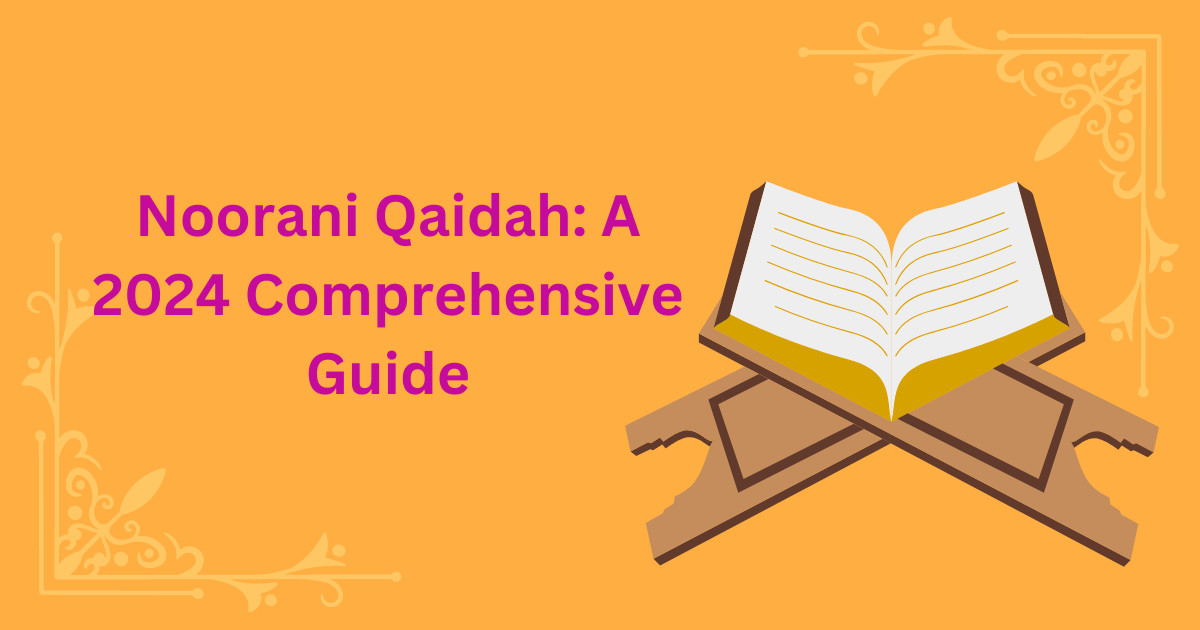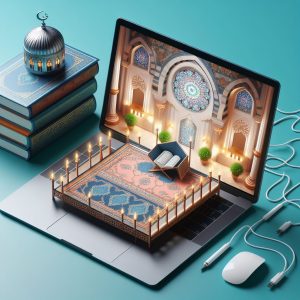Noorani Qaidah is one of the best methods that facilitate learning the Arabic language and Quran reading for children and adults. If you need help speaking Arabic or want to improve your reading and intonation skills, the Noorani Qaidah can help you reach your goal at a convenient time. It helps the child read the whole Quran at the age of four years.
Table of Contents
What is Noorani Qaidah?
Noorani Qaida is a textbook that consists of 40 chapters. Those chapters progress in a structured manner from the easiest to the most complex. It was designed to help experts teach beginners systematically, so it is considered a primary guide for learning the Arabic Alphabet, especially in the Quranic text by the gradual learning of each letter. It gives every letter a unique story, till you feel that all letters are familiar to you in any case.
Reciting the Quran with Tajweed requires learning Noorani Qaida to master Quranic Arabic without mistakes. For non-Arabic Muslims, it’s challenging for them to read the verses correctly as the letters’ pronunciation is inevitably different from English grammar.
Proficiency at reciting Quran needs learning and comprehending the meaning beyond Quranic verses and acknowledging Islamic studies such as Fiqh, Hadith, and Aqidaah. So, the Noorani Qaida book is your gate to learning Quranic Arabic with Tajweed.
Noorani Qaida is an educational book with 17 chapters used widely in learning Arabic basics through teaching the letters and diacritical marks to beginners, whether kids or adults.
The book also focuses on teaching Tajweed rules to help non-Arabic to improve pronunciation for mastering recitation.
The writer used effective methods in learning the Arabic Alphabet, the phonics, and character traits.
This book’s massive popularity makes it one of the most prominent Quranic sciences books. Its name goes back to the Indian writer who was called “Noor Muhammed Haqqani”.
Noorani Qaida has other names such as Fathiya Qaida, Haqqania Qaida, Makkia Qaida, and Furqan Qaida.
Who wrote Noorani Qaidah?
It was written by Sheik Noor Muhammad Haqqani. He was born in the state of Punjab in India. He completed his legal studies in one of its famous religious schools, and after that, he completed his studies in the specialty of Hadith.
Noorani Qaida Lessons
You can get a brief about the book’s lessons to identify its rules before you start learning it:
Noorani Lesson 1 – learning alphabets
The first lesson of Noorani Qaidah’s book focuses on teaching single letters, which are 29. Seven letters feature deep pronunciation. They require using the whole mouth while pronouncing them.
Moreover, the lesson includes 4 letters that require moving lips while pronouncing.
Noorani Lesson 2 – Learning Murakkabat
The second lesson is about compound letters. It’s another form of Arabic letter that is composed once you conjoin two or three letters.
Noorani Lesson 3 – Learning Muqattat’at
In the third lesson, you identify the disconnected letters which are called in Arabic “Muqattat’at”.
These disconnected letters are related to the Quran. They make 14 words which are abbreviated. Each word of them is one verse in 29 surahs. They came in the first verse of all surahs.
Noorani Lesson 4 – Harakat Learning
The fourth lesson’s title is about letter movements which are called “Harakat” in Arabic. They are Kasra, Fatha, and Dammah.
Noorani Lesson 5 – Learning Tanween
You’ll learn in this lesson “Tanween” marks that consist of double fatha, double dammah, and double kasra.
Noorani Lesson 6 – Learning owel letters and tanween marks
You’ll find in this lesson examples of Quranic words that contain vowel letters and tanween marks. It helps the students to practice the proper pronunciation of these words.
Noorani Lesson 7 – Learning three short vowels
The seventh lesson focuses on prolonging the pronunciation of letters through three short vowels: small alif, small yaa, and small waw.
Noorani Lesson 8 – Learning “Madd’ah and “Leen” signs.
You’ll learn in this lesson “Madd’ah and “Leen” signs. They are diacritical marks of prolonged pronunciation.
Noorani Lesson 9 – Exercises on the above
In the ninth lesson, you’ll find exercises of Tanween, prolonged “maddah” and soft leen letters through practicing some Quranic words.
Noorani Lesson 10 – Sokoon Learning
This lesson is about a sukoon mark that doesn’t include a vowel.
Noorani Lesson 11 – Practice Sokoon
You’ll practice in lesson 11 how to pronounce Arabic words with a sukoon mark.
Noorani Lesson 12 – Learning Shaddah
The twelfth lesson focuses on teaching another diacritical mark, “shaddah”. It requires a powerful voice while pronouncing due to duplicate letter reading.
Noorani Lesson 13 – Exercises of Shadda
This lesson is only for exercises of Shadda mark as you’ll practice how to pronounce different words.
Noorani Lesson 14 – Exercises of shadda and sukoon
You’ll find in this lesson extra exercises of shadda and sukoon marks. It’s a practice for pronouncing both marks in Arabic words.
Noorani Lesson 15 – Learning Duplication of shaddah
This is another lesson of exercises to practice how to pronounce duplication of shaddah in one word.
Noorani Lesson 16 – Maddah movement Learning
The sixteenth lesson is an exercise for shadda, a sukoon mark with maddah movement. This lesson is about improving pronunciation with more than a diacritical mark.
Noorani Lesson 17 – Quranic Arabic words with Tajweed Learning
The final lesson is a revision of all previous chapters to the master the pronunciation of Quranic Arabic words with Tajweed.
Benefits and Importance of Noorani Qaidah
The Noorani Qaidah has long been widely accepted by Muslims since its release, due to its many benefits for children and also for adults:
Benefits and Importance for Children
Your children will be happy if they learned the Arabic language, but it may seem difficult especially if it was not their mother tongue. The noorani Qaida will not only facilitate the Arabic language, but it will also change their personalities.
1. Facilitate learning the Arabic alphabet:
Noorani Qaida divides the Arabic alphabet into vocal groups, so learning them becomes easier. It will also help one understand the letter articulation point and distinguish between the letters that have similar sounds.
2. Improve reading and writing skills:
Once you learn each letter sound and relate to its shape correctly, you will then be able to form words and then sentences. This will help you achieve a better understanding of the Arabic text generally.
3. Improve kids’ attention and concentration
As Noorani Qaidah requires interactive tasks that require focusing on voices and letter shapes, it will help kids improve their attention span and concentration skills, which will subsequently improve their results.
4. Better practicing of the Arabic language:
Noorani Qaida will present your kid with the practice they need to build their linguistic skills in the realm of the Arabic language. With Noorani Qaida, your child will like the Arabic language and this makes speaking in Arabic an interesting mission. The gradual learning and continuous practice of the Arabic language resembles a magical tool to build their linguistic skills.
5. Improve quranic intonation:
Although Nooran Qaida paid great attention to the Arabic language, you will be able to read the Quranic text better, Since the Quran is an Arabic text as Allah says:
“بِلِسَانٍ عَرَبِيٍّ مُّبِينٍ” (الشعراء 195)
“In a clear Arabic language”. (Ash-Shuara 195).
Benefits and Importance for Adults
Some people think that Noorani Qaida is only for children, but it will also be very helpful for adult beginners.
1. Easy to understand:
Even if you have never learned the Arabic language or tajweed before, Noorani Qaida will make it easy. Since you learn Arabic gradually, start with the easier lessons at the beginning of the book to the hardest ones.
2. Practical application:
Noorani Qaida provides practical examples that will help kids and adults alike to better grasp the linguistic rules of the Arabic language. Everything you learn in the Qaida, you should apply by reading ayat. Furthermore, the textbook is designed for application and supplied with audio to know the right sound.
3. Short time needed:
Using the Noorani Qaida, you can grade up your intonation in a very short period compared to other methods. If you want to achieve this you should start systematic learning and put a time-bound plan.
The topics covered in Noorani Qaidah:
The topics covered in Noorani Qaidah are explained in the book of the Qaidah, but you will need to use also the separate records, and the holy Quran to get a firm grasp on them.
These topics include:
1- The Arabic alphabets
The Noorani Qaida includes the basics of the Arabic alphabet. you will know how to read and write each letter. You will know the Taskheil and its sound effects.
2- The Tajweed
Tajweed Includes Basic Quranic recitation principles and Rules of Tajweed including letter combinations, long and short vowels, and sun and moon letters. As we know: “Tajweed is the intonation of letters and knowledge of when to stop”
3- The Arabic grammar at the advanced levels
You will understand how to form sentences and how to know the part of speech of each word, which improves your understanding of the meanings.
How to Learn Noorani Qaidah?
You can learn independently at home, in Islamic schools, or through online courses. You can learn the Noorani Qaidah by following these steps:
1. Buy the textbook:
You can find it in Islamic bookstores or online retailers, you will also need the audio. Start learning the shape of the alphabet, and write each letter in the isolated form and inside the word.
2. Connect the shapes with the sounds:
Try to say each letter alone and in different words, then, try to keep them and examine yourself using the visual aids and audio resources provided in the textbook or online.
3. Continue practicing and repeat as much as you can:
“Practice makes perfect”, an adage that means that there is no learning without practice, as you will forget rapidly. You can start practicing with simple Arabic texts and then short Quranic texts.
4. Study the Tajweed rule:
Noorani Qaida includes several Tajweed rules. Use the explanations and examples in the textbook to understand the concepts, and try to apply them to the Quranic text.
5. Try to find someone to practice with:
Find a studying peer to share the joyful moments and the moments of frustration and make the journey less lonely. After a short period of repetition, you will find them easier and you will be able to read the whole Quran without help.
Is Noorani Qaidah the best choice for kids?
Noorani Qaidah is one of the best choices for kids but we all know that every child has a unique identity. They have different mental abilities and different lifestyles. So it is better to ask their beloved teacher or an expert to guide you to the best choice for your kids.
Alternatives To Noorani Qaidah
There are many alternatives for Noorani Qaidah including the following:
1- Madani Qaida:
Madani Qaida focuses on tajweed and application by providing reading practice of Quranic texts, so it will be more suitable for advanced level. You can start with Madani Qaida if you are interested in tajweed to improve your Quranic reading.
2- Noor al-Bayan:
Noor Al-Bayan is considered a comprehensive reference for learning the Arabic language and is usually used in religious schools and institutes as it covers diverse topics such as grammar, rhetoric, literature, jurisprudence, and interpretation.
Difference Between Noorani Qaidah & Madani Qaida
Noorani Qaidah and Madani Qaida have the same objective, but they follow different methods. They are very similar but this little difference makes each one suitable for different cases.
1. The writer:
Unlike Noorani Qaida, the Madani Qaida was written By Abdul Mohsen bin Muhammad Al Qasim. He was born in Saudi Arabia. He was a very skilled reader and jurist.
2. The method of explanation:
Madani Qaida focuses mainly on the Quranic texts from the beginning, thus you can understand by practicing. As for the alphabet, it is just an introduction of all the following lessons.
3. The emphasis on Tajweed rules
The emphasis on tajweed rules is more prominent in Madani Qaida than in the Noorani Qaida. This means Noorani Qaida will be more suitable for beginners.
4. The popularity:
Noorani Qaida is popular in India and Asia countries, but Madani Qiada is common in Arab countries.
Noor Al-Bayan vs Noorani Qaidah:
Noor Al-Bayan and Noorani Qaidah meet in some aspects and depart from each other in other aspects:
| object | Noor al-Bayan | Noorani Qaidah |
| The goal of learning | To cover Quranic recitation and Tajweed rules. | To cover the basics of Arabic letters and their pronunciation. |
| Who will benefit the most from it | Advanced learner | Beginners |
| Time needed | Requires more time | Relatively less time |
At what age should a child learn Noorani Qaidah?
There is no constant age since the best time is affected by every kid’s abilities. In most cases, the 3 to 5 age is suitable, as the kids of this age usually can concentrate and learn rapidly.
How long does it take to finish Qaidah?
The average time required ranges from 6 months to 1 year. Though, you can finish in 2 months or more according to consistency and compliance in studying. On the other side, you can also take your time and give a convenient time for each lesson.
Best Noorani Qaida Course
For beginners, it’s hard for them to understand all the lessons in the Noorani Qaidah book as they haven’t been familiar with Arabic basics yet.
However, learning Noorani Qaida can be more straightforward and understandable if you understand the book with a professional instructor who explains the book lessons in a streamlined and direct method, in addition to practicing the correct pronunciation through the exercises’ lessons.
In the Noorani Qaidah course of Bayan Al-Quran Academy, you’ll learn how to read Quranic Arabic, long and short Arabic vowels, recite full verses with Tajweed, and improve your linguistic skills.
This course is online and fits all ages, whether kids or adults. It saves time, unlike learning by yourself, and offers an interactive environment to practice with your tutor.
Learn Arabic Online With Bayan al-Quran Native Arab Tutors:
Embark on a transformative journey of Arabic learning with Bayan Al-Quran’s comprehensive online Arabic courses. Our platform offers an authentic and immersive experience tailored to learners worldwide. Whether you’re a beginner or seeking to enhance your skills, our Tajweed courses provide expert guidance and structured learning to master Arabic learning.
🎓 Expert Guidance:
Benefit from experienced instructors who specialize in Arabic, breaking down complex rules into manageable segments for learners of all levels.
✨ Key Features:
- Structured, step-by-step learning approach.
- Access to high-quality instructional materials.
- Real-time feedback from qualified tutors to enhance your practice.
- Flexible learning schedules to accommodate your pace and convenience.
- Immerse yourself in the melodious tones of Quranic recitation, enriching your spiritual experience.
🌟 Why Choose Bayan Al-Quran?
Join our vibrant community dedicated to perfecting Arabic learning. Choose Bayan Al-Quran for a transformative learning experience and embark on a path to mastering Arabic with confidence.
Learn with Bayan al-Quran with Native Arab tutors. There are also several courses that can help you in this regard.
Conclusion:
Noorani Qaidah is a structured textbook consisting of 40 chapters designed to teach the Arabic alphabet and Quranic text systematically. Authored by Sheik Noor Muhammad Haqqani, it facilitates learning through gradual, interactive lessons that enhance reading, writing, and pronunciation skills.
The book benefits both children and adults by simplifying Arabic learning, improving concentration, and enhancing Quranic intonation. Noorani Qaidah is often used in Islamic schools, online courses, and independent study, requiring consistent practice and application.
Alternatives like Madani Qaida and Noor al-Bayan offer different focuses, such as advanced tajweed and comprehensive Arabic language studies.
The optimal age for children to start is 3 to 5 years, with completion times varying based on dedication.

















